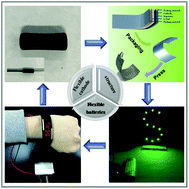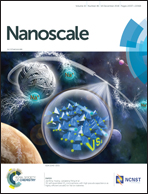A carbon foam-supported high sulfur loading composite as a self-supported cathode for flexible lithium–sulfur batteries†
Abstract
A binder-free, self-supported, flexible cathode is explored for application in flexible lithium–sulfur (Li–S) batteries. The cathode is constructed using nitrogen (N)-doped carbon foam/carbon nanotubes (CNTs) as the scaffold and filled with poly(3,4-ethylenedioxythiophene) (PEDOT)-encapsulated sulfur nanoparticles as the active material. The dense CNTs coated on the skeleton of the 3D N-doped foam enhance flexibility, and the highly conductive CNTs are crossed and twined together to create an interconnected skeleton for rapid electron transport. The conductive PEDOT shell of sulfur nanoparticles and the N-doping of the carbon foams restrain the dissolution of polysulfides through the enhanced chemisorption of lithium polysulfides. The best cathode with a sulfur loading of 2.6 mg cm−2 has an eminent capacity of 1395 mA h g−1 during the initial cycle at 0.1 C. Furthermore, freestanding cathodes are assembled into flexible Li–S batteries, which demonstrate significant achievement at various bending angles. The capacity fading rate is 0.16% per cycle at 30° after 120 cycles. Its high sulfur loading, high capacitance, and good flexibility make this cathode material a promising candidate for potential application in flexible electronics.

- This article is part of the themed collections: Top articles from NCNST and Research selection from the NCNST


 Please wait while we load your content...
Please wait while we load your content...